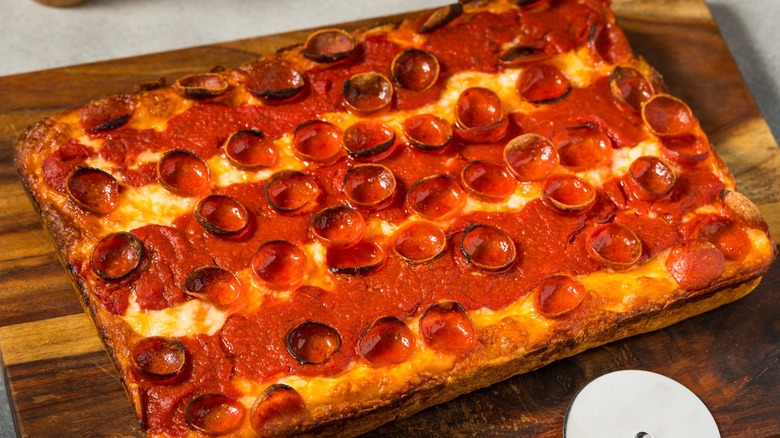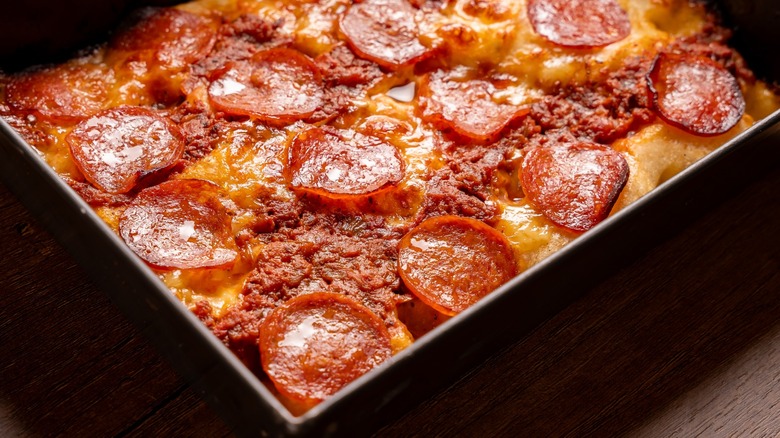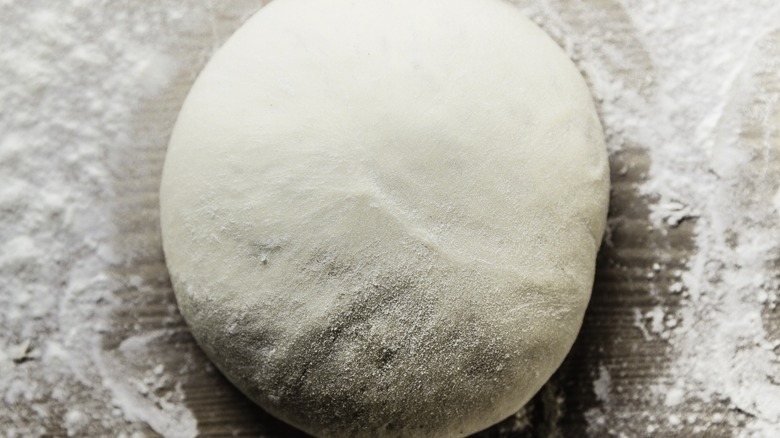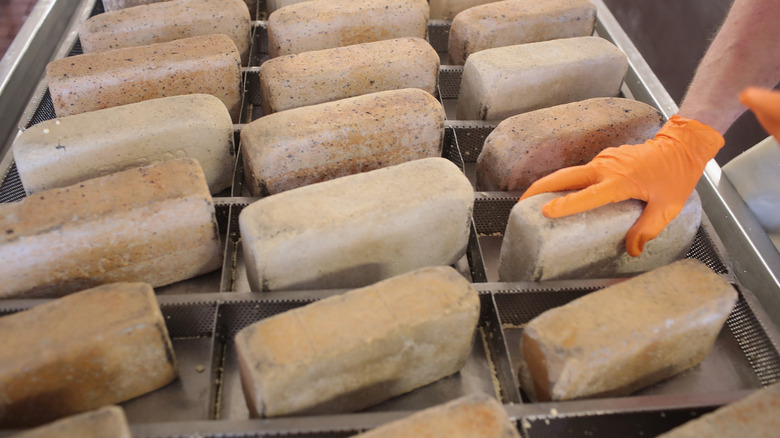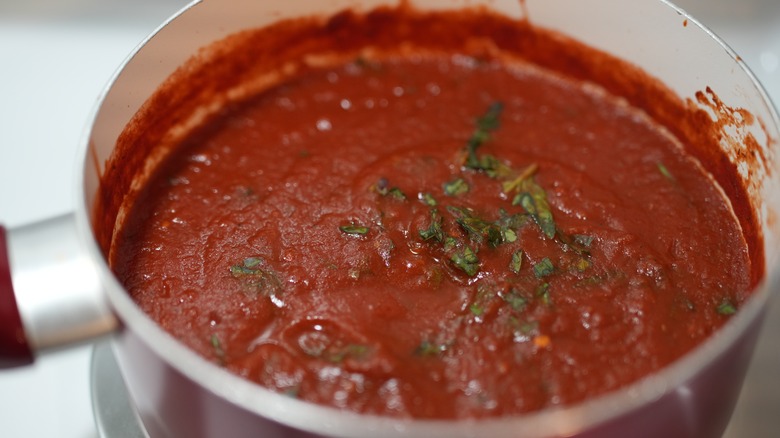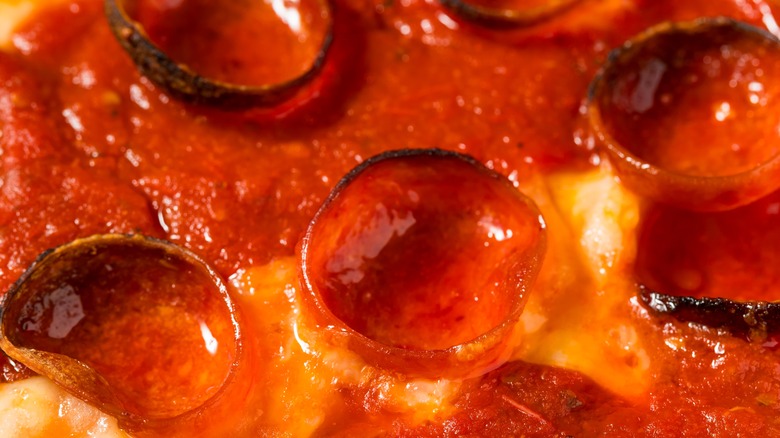5 Tips To Make The Best Detroit Style Pizza At Home
We may receive a commission on purchases made from links.
Italian immigrant Gus Guerra invented the first Detroit-style pizza in 1946 in an attempt to add new food items to the menu at his neighborhood bar, Buddy's Rendezvous. Hoping to capture the Sicilian-style pies he remembered enjoying as a child, Guerra created the distinct thick-crusted, crispy edged pizza in a rectangular blue steel pan and the rest, as they say, is history. Detroiters in-the-know have been devouring the signature square-shaped pizza for nearly 80 years.
But it wasn't until Shawn Randazzo, owner of Cloverleaf Pizza, entered his pie into the 2012 International Pizza Expo in Las Vegas that the rest of the country caught on to this new cheesy marvel. Today, everyone from local pizzerias to national chains like Jet's Pizza and Little Caesar's are making Detroit-style pizza. You can even get it frozen at your local grocery store, but if you want to make this Michigander favorite from scratch, there's several tips you'll want to keep in mind.
The pan makes the pizza
New York pizza is known for its crispy, yet foldable crust, Neapolitan-style pizza is much smaller in size with simpler ingredients, and Chicago-style pizza is the complete opposite, a thick, deep-dish pie where one slice is more than a meal. Although Detroit-style pizza possesses other peculiarities, its most defining characteristic is the dark, rectangular pan it's baked in.
It seems all too apropos that the city which birthed our nation's automobile industry would offer a pizza baked in a blue steel pan, which is commonly used to sanitize auto parts in manufacturing plants. Able to withstand high temperatures, it is the perfect vehicle to make Detroit-style pizza's signature crispy crust, fried in olive oil and cheese fat.
If you want the most authentic experience without hopping a plane to Detroit, you should purchase an anodized steel pan online. But you can get close using a 12-inch cast iron skillet or a couple of 8-inch square metal cake pans.
Dishing the right dough
Similar to Sicilian-style pizza, which was what Gus Guerra was trying to replicate, Detroit-style pizza has a chewy, thick, focaccia-like crust with a crisp exterior and airy crumb. Since we want the dough to be substantial, it's best to start with bread flour, which is considered a "stronger" flour than all purpose flour. It also has a higher protein content, which aids in gluten development, resulting in a stretchier, chewier crumb. Another factor to keep in mind is the moisture content.
The amount of water (in other words, the hydration) used in your pizza dough will affect the outcome of your crust. Low hydration equals a denser crust, while high will be lighter, featuring a holey, more open crumb and a crispier crust. In his recreation of the Detroit classic, chef Kenji López-Alt uses a 75% hydration, meaning ¾ of his dough recipe is water (that is, 300 grams of bread flour to 220 grams of water). He also advises letting the dough rest for 10 minutes after mixing, a method referred to as autolyse, which allows the flour to become fully hydrated. This makes it easier to form gluten while kneading.
The right cheese, if you please
Since what we're going for is authenticity, a Detroit-style pizza wouldn't be complete without Wisconsin brick cheese. A semi-ripened cow's milk cheese, brick cheese gets its name from the way it was traditionally formed, by being squeezed between two bricks to exude the whey. The younger varieties of brick cheese have a high fat content, and a mild, buttery flavor. It also melts exceedingly well, making it the perfect candidate for crafting the crispiest grilled cheese sandwich – or a Detroit-style pizza.
If you don't live anywhere near Wisconsin, or can't find brick cheese from your local cheesemongers or specialty supermarkets, you can always order Wisconsin brick cheese online. That being said, some recipes claim you can get away with a 50/50 mix of low-moisture mozzarella and Monterey Jack cheese, but it's still suggested that you cube or slice the cheese yourself, as pre-shredded cheese contains anti-caking blends that will hinder the ooey-gooey melt factor you're looking for.
A simple sauce
A great pizza sauce should be simple and thick, so as not to sog your crust, and Detroit-style pizza is no different. Seasonings include (but aren't limited to) fresh garlic, oregano, and pepper flakes, but be sure to use crushed tomatoes — either a good canned version such as Cento or San Marzanos — or peel and crush them yourself in a food mill or processor. One key ingredient in Detroit-style pizza sauce is granulated garlic or garlic powder and onion powder. It just won't taste right without it.
After sauteeing the seasonings in good olive oil and adding the crushed tomatoes and granulated garlic, you'll want to simmer the sauce for at least half an hour. You want the sauce to reduce until it's nice and thick. It's up to you whether or not to add sugar to your tomato sauce, a technique used to reduce the tomatoes' acidity, but we're not going to argue about whether or not that's taboo.
Get it together and bake it
Finally, Detroit-style pizza is layered in a specific way for maximum flavor and crust crispiness. After getting the well-oiled dough down in the pan, you'll be tempted to add the sauce, but don't give in! The first ingredient after the dough should be the meaty toppings, such as thick sliced Old World pepperoni that you cut yourself for optimal cupping. Next is the cubed cheese, making sure all the edges are well lined, as the fat from the cheese is what helps make the crispy-fried crust that Detroit-style pizza is known for. Then, lay down the sauce in three long stripes, alternatively known as tire tracks, to finish the look and feel of an authentic, Detroit-style pie.
Finally, finish with even more cup-shaped pepperoni. If you don't own a pizza oven, be sure to preheat your standard oven to the highest temperature, anywhere from 500 to 550 degrees Fahrenheit. Depending on your oven, you'll want to focus on getting the bottom of the pan hot in order to cook the dough to maximum crispiness without burning the toppings. If you have it, you can try baking it on top of pre-heated cooking steel, or, if your appliance heats from the bottom, place the pan right on the floor of the oven.
